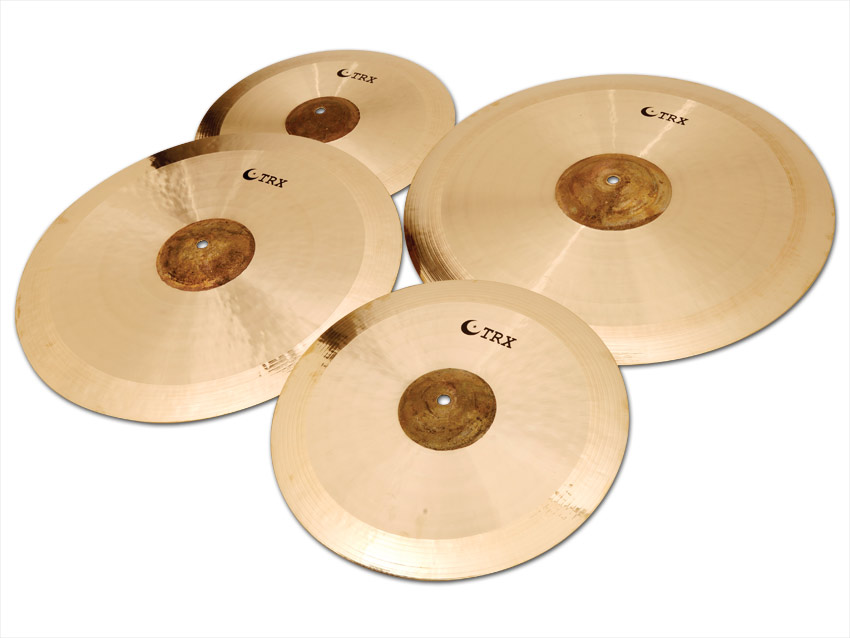MusicRadar Verdict
They're not hugely ballsy or brash, nor at the other extreme, exceptionally dark and trashy. The sounds are controlled and sparkling and will no doubt record well. Absolutely worthy of your consideration.
Pros
- +
Unique look: tasteful, tasty and classy. Bright edge, warm centre.
Cons
- -
Not suited to particularly heavy players.
MusicRadar's got your back
TRX is short for Turks and yes, these professional quality cymbals are made in Turkey following age-old crafting techniques. The four cymbals we're looking at today are from the latest LTD (Limited) series.
There are four other series: BRT (Bright), DRK (Dark), ALT (Alternative) and MDM (Medium). You may find the text-speak titles cool or you may not, but the idea's simple, modern and it works. In fact the whole TRX philosophy is to keep things straightforward. The series titles speak for themselves and all five series are offered at the same price.
The text-speak's other aim is to attract younger customers. Kevin Morris of UK distributor Morico suggests that the marketing of other traditional, Turkish style cymbals has been targeted at an older generation of jazz fans. This is a shame, since genuine Turkish cymbals can just as well appeal to younger drummers of all styles.
Build
The four cymbals featured here comprise a 20" and 18" crash/ride, plus a pair of 14" hi-hats. They're sold as a set and come with a free deluxe TRX carrying bag, although this was seemingly not available at the time of the review. All of the TRX cymbals have the same foundation, hand-made from cast B20 bronze in the traditional Turkish manner.
"The polished edge also makes normal crash-riding a real joy - the deep ride pattern being punctuated by firework-bright whooshing explosions"
The variations in each of the five series result from the way in which they're treated, worked and finished. Also, each of the series varies in weight: some are heavier - and thus inherently brighter/louder -than others. The LTD cymbals are medium weight, very slightly heavier than the MDM (Medium) series.
The LTD cymbals are certainly eye-catching due primarily to the three-band surface treatments. The outer edges are polished to a brightshine, the idea here being to add "brightness and explosiveness to the crash component of the sound".
The bell meanwhile is left completely unfinished, a decision that TRX took "to increase the definition and articulation". The central riding area or 'face', meanwhile, has a satin sheen with fine lathing and gentle hand hammering. The cymbals are finished the same top and bottom.
Hands-on
The 20" certainly lives up to its crash-ride description. The central riding area has a reassuring, tasteful, warm tone. There's a really creamy depth, but not the sort of mega trashy sound of out-and-out traditional Turkish rides. Articulation is clear without being abrupt. Overtones are controlled but still provide plenty of character.
If you want a really well-spread sound, move further towards the edge. In fact, if you're not too heavy-handed you can actually ride right on the outer, polished edge band. The result is a deep, soft wash. Even at this extreme, the cymbal can take it without completely washing out. The polished edge also makes normal crash-riding a real joy - the deep ride pattern being punctuated by firework-bright whooshing explosions.
As you'd expect, there's a marked contrast with the unlathed bell. It jumps out of the cymbal, but doesn't sound disconnected or unnatural. It just provides a sharp colour contrast that's pingy and perky.
All of the above applies to the 18" also, except that it's higher pitched and correspondingly less powerful. It works as a ride, but really comes into its own with a light to medium stick, maybe one with an Erskine-style round acorn, or a Gadd-style small barrel. It's not the sort of cymbal you'd take a heavy stick to.
We imagine it tinkling harmoniously behind a jazzy piano or acoustic guitar, say, complementing a dynamic drop in the arrangement. It's a cymbal to be coaxed and engaged, not thrashed.
We did manage to ride it occasionally during the two rock gigs on which we tried out the whole set, but it was far more effective as a crash. In that respect it was brilliant, fast and cutting with a sparkling decay, almost splash-like with an exotic hint of trashiness. The full crash sound of the 20" is also bright, but rather more plump, once again controlled and sharp-edged for a large cymbal.
The 14" hats have the same three-band design as the rides/crashes. It's not so instantly obvious how this benefits the sound, but on careful experimenting you realise the bright thin edge gives your half-open splash and shouldered Purdie-style 'barks' a thrilling bite and rapid response.
The centre closed sound is a deep tick, nicely old fashioned and authoritative. The small raw bell gives you a further crisp option, another timbre if you're getting adventurous with your hi-hat licks and grooves. The pedalled sound also benefits from the buffed outer edge, giving it a clean if not super-cutting two and four.
“I got a call saying, ‘Robert Plant is going to call you.’ What?!”: How Alison Krauss made sweet music with the Led Zeppelin legend
How we test digital pianos
Zak Starkey is back in The Who. “I take responsibility for some of the confusion… Zak made a few mistakes and he has apologised”, says Pete Townshend










